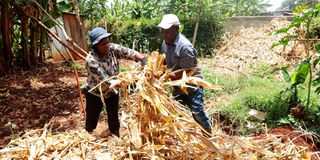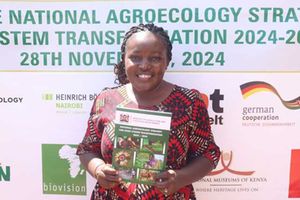Soil cover: A nature-based solution for climate resilience in Africa

Ms Wambui Muguti and her husband Christopher Muguti planning to mulch at their farm in Mutuini, Nairobi on March 17,2025.
What you need to know:
- Healthy soil functions as a sponge, storing water during rains and releasing it gradually during dry spells.
- Soils rich in organic matter can hold between 154,000 and 234,000 litres of water per hectare.
Africa’s vulnerability to climate change is undeniable, yet the continent possesses some of the most effective, nature-based tools for adaptation.
Soil cover - like living vegetation, mulch, or crop residue - is one such tool. It offers farmers, urban planners, and policymakers a way to mitigate heat, conserve water, reduce emissions, and enhance food security without large-scale infrastructure or expensive technology.
When prolonged droughts hit or unexpected downpours erode farms in arid areas, soil health often determines whether crops survive or fail. A recent report by the Coalition for Soil Health found that farms adopting cover cropping and reduced tillage in sub-Saharan Africa achieved 25 per cent higher sorghum yields during prolonged dry seasons. Farmers who applied compost and mulch in Kenya's drylands saw maize yields rise by 30 per cent during droughts. These are agricultural wins grounded in the science of soil cover.
Also read: Here’s what ails Kenya’s soils
Soil cover shields the earth from extreme weather, locks in moisture, and captures carbon. In Africa, where smallholder farmers are the backbone of food systems, scaling up soil cover practices offers a low-cost, high-impact strategy for climate adaptation.
Healthy soil functions as a sponge, storing water during rains and releasing it gradually during dry spells. Soils rich in organic matter can hold between 154,000 and 234,000 litres of water per hectare. When protected by vegetation or mulch, this moisture stays longer, reducing plant stress and maintaining crop yields.
During the 2023 US Midwest droughts, farms using no-till systems retained 20 per cent more moisture. Similar benefits have been documented in African contexts. In Kenya and Tanzania, conservation agriculture practices like cover cropping and mulching helped farmers weather erratic rainfall, stabilising incomes and harvests.
Soil cover also protects against erosion. Vegetative layers reduce surface runoff by up to 90 per cent, preventing valuable topsoil from being washed or blown away. During heavy rains, covered soils absorb water 10 to 40 per cent faster, reducing flood risks and recharging groundwater supplies.
With rising temperatures across the continent, the ability of soil cover to moderate heat is gaining attention. Bare soils can become dangerously hot, threatening root systems and microbial life. Covered soils, by contrast, are 2.5 to 10 degrees Celsius cooler.
Trees and shrubs provide the strongest cooling effect. Shaded surfaces can be 11 to 25 degrees Celsius cooler than exposed areas. This thermal buffer helps maintain biodiversity below ground, supporting nutrient cycling and plant growth. Green roofs and park forests have been shown to reduce soil temperatures while improving stormwater absorption in urban areas.
Soil, the carbon sink beneath our feet
Soil is one of the largest carbon sinks on the planet. For every one per cent increase in soil organic content, soils can store an additional eight to 12 tonnes of carbon per hectare. Practices like cover cropping, mulching, and agroforestry are central to enhancing this storage.
Covered soils also reduce greenhouse gas emissions. Lower soil temperatures and minimal disturbance slow the decomposition of organic matter, cutting CO2 releases by 15 to 30 per cent compared to bare soils. Agroforestry systems that maintain permanent soil cover can sequester two to four times more carbon than conventional farming setups.
In a 2025 study published in Frontiers in Environmental Science, urban forest parks were found to sequester 35 per cent more carbon than grasslands. These same parks also recorded soil temperatures of 2.5 degrees Celsius lower than bare urban surfaces, confirming the dual climate benefits of vegetative cover.
Beneath the surface, a web of microbial life powers nutrient recycling and plant health. Soil cover creates favourable conditions for these organisms to thrive. Cover crops and mulch support microbial activity, enhance nutrient availability, and improve plant resilience against pests and diseases, all critical in a shifting climate.
Using deep-rooted cover crops like oil radish, biological tillage breaks up compacted soils naturally, improving aeration and water percolation. This supports healthier root systems and enhances plant access to water and nutrients.
Soil cover is not just for rural landscapes. Urban greening projects increasingly use soil cover strategies to manage heat, water, and carbon. Green roofs reduce building temperatures by up to 20 degrees Celsius. Street trees lower asphalt temperatures by 10 to 15 degrees Celsius, easing urban heat stress.
Parks designed with tree dominance rather than open grassland better regulate soil pH and temperature, enhancing their role as carbon sinks. These interventions offer cost-effective solutions for cities seeking to build climate resilience while improving livability.
In conservation agriculture, soil cover is a principle. Cover crops stabilise soil between planting seasons, recycle nutrients, and suppress weeds. Mulching with residues protects soil structure and boosts microbial life.
Policy frameworks across Africa are beginning to recognise the strategic importance of soil cover. In drought-prone regions, advisory services promote composting, mulching, and rotational planting as adaptive tools for farmers. Integrating these practices into national climate action plans could scale their benefits.

